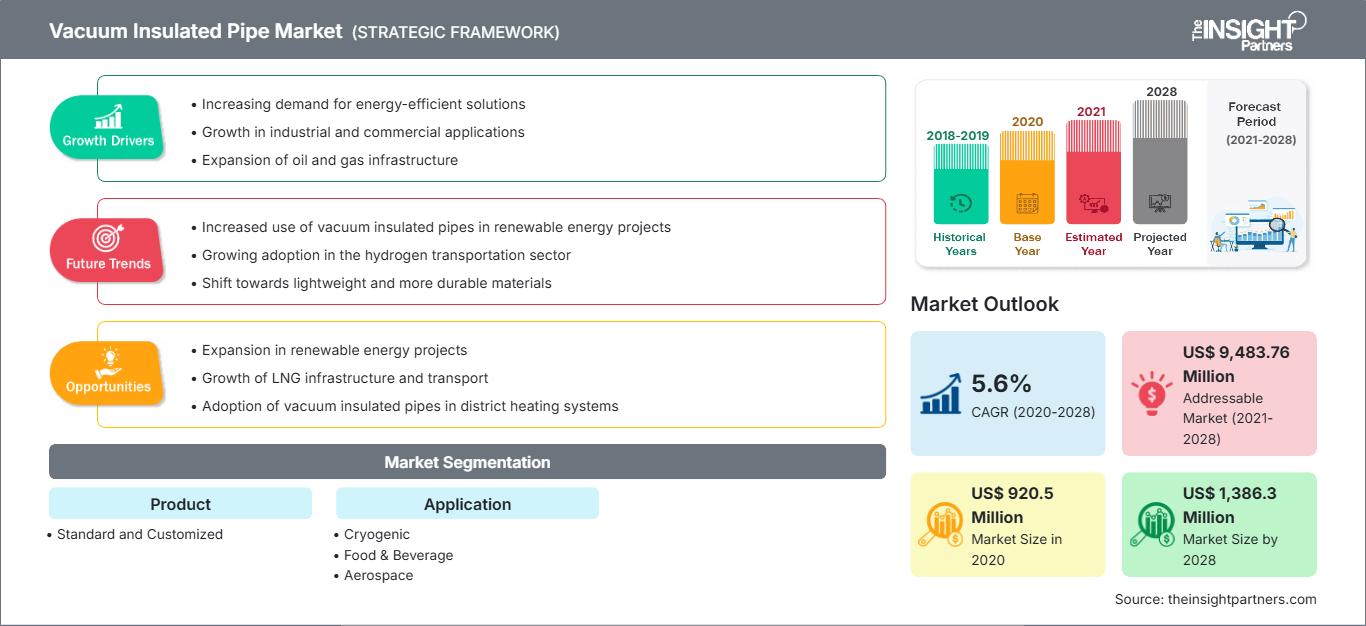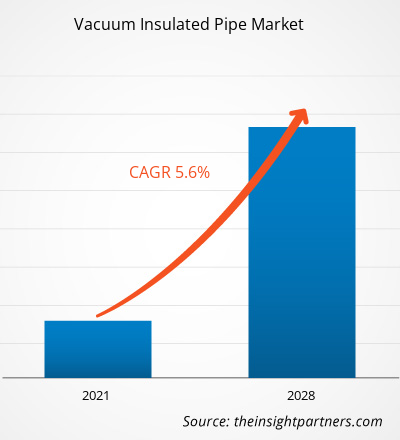Der Markt für vakuumisolierte Rohre hatte im Jahr 2020 einen Wert von 920,5 Millionen US-Dollar und soll bis 2028 1.386,3 Millionen US-Dollar erreichen; für den Zeitraum 2021–2028 wird ein CAGR-Wachstum von 5,6 % erwartet.
Der Markt für vakuumisolierte Rohre wird im Prognosezeitraum voraussichtlich ein beträchtliches Wachstum verzeichnen. Der Einsatz von vakuumisolierten Rohren in LNG-Anwendungen nimmt aufgrund ihrer Vorteile zu, wie z. B. geringere Rückverflüssigung, weniger Flüssigkeitsverluste und höherer LNG-Durchfluss über größere Entfernungen, was das Wachstum des Marktes für vakuumisolierte Rohre vorantreibt. Darüber hinaus beschleunigt die steigende Nachfrage der Endverbraucher nach vakuumisolierten Rohren aufgrund ihrer überlegenen Isoliereigenschaften, Haltbarkeit und Wartungsfreiheit das Marktwachstum weiter.
Der Markt für vakuumisolierte Rohre ist nach Produkt und Anwendung segmentiert. Basierend auf den Produkten wird für das Segment Sonderanfertigungen im Prognosezeitraum ein höheres CAGR-Wachstum erwartet. Das Marktwachstum in diesem Segment ist auf die steigende Nachfrage nach kundenspezifischen vakuumisolierten Rohren in den Bereichen Öl und Gas, Energie sowie Gesundheitswesen aufgrund der branchenspezifischen Spezifikationssysteme zurückzuführen. Basierend auf der Anwendung wird erwartet, dass das Segment Lebensmittel und Getränke den größten Marktanteil halten wird. Das steigende Pro-Kopf-Einkommen der Verbraucher sowie die Entwicklung des Lebensmittelverpackungssektors sind die wichtigsten Wachstumsfaktoren in der Lebensmittel- und Getränkebranche. Darüber hinaus bietet der zunehmende Handel mit verpackten Lebensmitteln und Tiefkühlprodukten dem Markt für Sonderanfertigungen lukrative Geschäftsmöglichkeiten.
Passen Sie diesen Bericht Ihren Anforderungen an
Sie erhalten kostenlos Anpassungen an jedem Bericht, einschließlich Teilen dieses Berichts oder einer Analyse auf Länderebene, eines Excel-Datenpakets sowie tolle Angebote und Rabatte für Start-ups und Universitäten.
Markt für vakuumisolierte Rohre: Strategische Einblicke

-
Holen Sie sich die wichtigsten Markttrends aus diesem Bericht.Dieses KOSTENLOSE Beispiel umfasst Datenanalysen, die von Markttrends bis hin zu Schätzungen und Prognosen reichen.
Laut dem jüngsten Bericht der Weltgesundheitsorganisation (WHO) gehören die USA, Spanien, Italien, Frankreich, Deutschland, das Vereinigte Königreich, Russland, die Türkei, Brasilien, der Iran und China zu den am schlimmsten vom COVID-19-Ausbruch betroffenen Ländern. Die COVID-19-Krise beeinträchtigt die Industrien weltweit, und die Weltwirtschaft wurde 2020 am stärksten getroffen. Dieser Schlag wird sich voraussichtlich auch 2021 fortsetzen. Der Ausbruch hat zu erheblichen Störungen in Primärindustrien wie der Nahrungsmittel- und Getränkeindustrie, der Medizinindustrie, der Energie- und Stromindustrie, der Elektronik- und Halbleiterindustrie, der Erdöl- und Chemieindustrie geführt. Die Fabrikschließungen, Reiseverbote, Handelsverbote und Grenzschließungen zur Bekämpfung und Eindämmung des Ausbruchs haben sich auf die Herstellung, die Lieferung und den Verkauf von Industrieanlagen ausgewirkt, die für die Herstellung von vakuumisolierten Rohren benötigt werden. Ein erheblicher Rückgang der Aktivitäten in der Industrie behindert das Wachstum des globalen Marktes für vakuumisolierte Rohre.
Markteinblicke in vakuumisolierte Rohre: Unterstützung von Richtlinien für saubere Kraftstoffe
Mehrere Regierungsbehörden auf der ganzen Welt unterstützen und setzen Richtlinien für saubere Kraftstoffe durch, die in den jeweiligen Regionen umgesetzt werden. So verabschiedete beispielsweise der Senat des Bundesstaates New Mexico im März 2021 einen Gesetzentwurf zur Einführung eines Standards für saubere Kraftstoffe, der dem Bundesstaat dabei helfen dürfte, seine Ziele zur CO2-Reduktion zu erreichen. Solche Initiativen konzentrieren sich auf die Einschränkung der Verwendung konventioneller Kraftstoffe im Transportwesen. Daher wird erwartet, dass sich Erdgas schnell als alternativer Kraftstoff etabliert und bis 2045 mit 25 % den zweitgrößten Beitrag zum Energiemix leistet. Im asiatisch-pazifischen Raum bieten viele Regierungen Verbrauchern Anreize, ihre Fahrzeuge auf Fahrzeuge mit sauberem Gas (LPG) umzurüsten. Die indische Regierung plant, die GST (Goods and Service Tax) auf Umrüstsätze drastisch zu senken und Verbraucher, die auf umweltfreundliche Kraftstoffe umsteigen, durch Subventionen zu unterstützen. Darüber hinaus würde das Wachstum des Marktes für vakuumisolierte Rohre in der Region durch die steigende Nachfrage nach Flüssigerdgas (LNG) in den schnell wachsenden Sektoren Luft- und Raumfahrt und Fertigung gefördert. Daher steigern zunehmende Regierungsinitiativen zur Einführung von Richtlinien für saubere Kraftstoffe die Nachfrage nach LNG und fördern in der Folge den Einsatz von vakuumisolierten Rohren in Öl- und Gasanlagen.
Produktbasierte Markteinblicke
Basierend auf dem Produkt ist der Markt für vakuumisolierte Rohre in Standard- und Sonderanfertigungen unterteilt. Das Standardsegment war 2020 marktführend. Standardrohre gelten als konventionell isolierte Rohre und halten den größten Marktanteil. Diese Rohre bestehen aus Stahl und werden mit einem Vakuum zwischen Innen- und Außenrohr verschmolzen. Die vakuumisolierten Rohre sind in verschiedenen Größen von 0,5 Zoll bis über 5 Zoll erhältlich. Darüber hinaus treibt die vielfältige Verwendung beim Transport großer Mengen kryogener Flüssigkeiten, darunter LNG, Wasserstoff, Stickstoff und andere, die Einführung von standardmäßigen vakuumisolierten Rohren voran. Die wachsende Zahl von KMU in den Schwellenländern im asiatisch-pazifischen Raum, die einfache Transportierbarkeit und die geringeren Kosten von Standardrohren im Vergleich zu kundenspezifischen vakuumisolierten Standardrohren sind weitere Faktoren, die das Marktwachstum im Segment der standardmäßigen vakuumisolierten Rohre vorantreiben.
Akteure auf dem Markt für vakuumisolierte Rohre konzentrieren sich auf Strategien wie Fusionen, Übernahmen und Marktinitiativen, um ihre Position auf dem Markt zu behaupten. Einige Entwicklungen der wichtigsten Akteure sind unten aufgeführt: 2019 hat Air Liquide seinen Anteil an Air Liquide Munay Tech Gases (ALMTG) um 75 % erhöht. Das Joint Venture gab außerdem bekannt, dass es plant, bis zu 86 Millionen Euro in den Erwerb von Wasserstoff- und Stickstoffproduktionsanlagen der Raffinerie Atyrau zu investieren, die KazMunayGas gehört. Gemäß der neuen Vereinbarung wird LMTG diese Anlagen betreiben, um die Raffinerie in Atyrau mit Industriegasen zu versorgen. Im Jahr 2021 erwarb Acme Cryogenics, Inc. Cryogenic Experts, Inc. Ziel der Übernahme war es, die Produktlinie des Unternehmens im Bereich kryogener und nicht kryogener Spezialflüssigkeiten zu erweitern und seine Geschäftspräsenz an der Westküste der USA zu erhöhen.
Markt für vakuumisolierte Rohre
Markt für vakuumisolierte RohreDie Analysten von The Insight Partners haben die regionalen Trends und Faktoren, die den Markt für vakuumisolierte Rohre im Prognosezeitraum beeinflussen, ausführlich erläutert. In diesem Abschnitt werden auch die Marktsegmente und die geografische Lage für vakuumisolierte Rohre in Nordamerika, Europa, im asiatisch-pazifischen Raum, im Nahen Osten und Afrika sowie in Süd- und Mittelamerika erläutert.Umfang des Marktberichts über vakuumisolierte Rohre
| Berichtsattribut | Einzelheiten |
|---|---|
| Marktgröße in 2020 | US$ 920.5 Million |
| Marktgröße nach 2028 | US$ 1,386.3 Million |
| Globale CAGR (2020 - 2028) | 5.6% |
| Historische Daten | 2018-2019 |
| Prognosezeitraum | 2021-2028 |
| Abgedeckte Segmente |
By Produkt
|
| Abgedeckte Regionen und Länder |
Nordamerika
|
| Marktführer und wichtige Unternehmensprofile |
|
Marktdichte der Akteure für vakuumisolierte Rohre: Auswirkungen auf die Geschäftsdynamik verstehen
Der Markt für vakuumisolierte Rohre wächst rasant. Die steigende Nachfrage der Endverbraucher ist auf Faktoren wie veränderte Verbraucherpräferenzen, technologische Fortschritte und ein stärkeres Bewusstsein für die Produktvorteile zurückzuführen. Mit der steigenden Nachfrage erweitern Unternehmen ihr Angebot, entwickeln Innovationen, um den Bedürfnissen der Verbraucher gerecht zu werden, und nutzen neue Trends, was das Marktwachstum weiter ankurbelt.
- Holen Sie sich die Markt für vakuumisolierte Rohre Übersicht der wichtigsten Akteure
- Standard
- Kundenspezifisch
Markt für vakuumisolierte Rohre – nach Anwendung
- Kryogen
- Lebensmittel und Getränke
- Luft- und Raumfahrt
- Elektronikfertigung und -prüfung
- Sonstige
Markt für vakuumisolierte Rohre – Nach Geografie
-
Nordamerika
- USA
- Kanada
- Mexiko
-
Europa
- Frankreich
- Deutschland
- Italien
- Großbritannien
- Russland
- Rest von Europa
-
Asien-Pazifik
- China
- Indien
- Südkorea
- Japan
- Australien
- Rest von APAC
-
Naher Osten und Afrika
- Südafrika
- Saudi-Arabien
- VAE
- Rest von MEA
- Chart Industries Inc.
- Senior Flexonics
- Acme Cryogenics
- Cryeng Group Pty Ltd.
- Cryofab
- Cryowork, Inc.
- Demaco
- Sps Cryogenics BV
- Historische Analyse (2 Jahre), Basisjahr, Prognose (7 Jahre) mit CAGR
- PEST- und SWOT-Analyse
- Marktgröße Wert/Volumen – Global, Regional, Land
- Branchen- und Wettbewerbslandschaft
- Excel-Datensatz
Aktuelle Berichte
Erfahrungsberichte
Grund zum Kauf
- Fundierte Entscheidungsfindung
- Marktdynamik verstehen
- Wettbewerbsanalyse
- Kundeneinblicke
- Marktprognosen
- Risikominimierung
- Strategische Planung
- Investitionsbegründung
- Identifizierung neuer Märkte
- Verbesserung von Marketingstrategien
- Steigerung der Betriebseffizienz
- Anpassung an regulatorische Trends






















 Kostenlose Probe anfordern für - Markt für vakuumisolierte Rohre
Kostenlose Probe anfordern für - Markt für vakuumisolierte Rohre